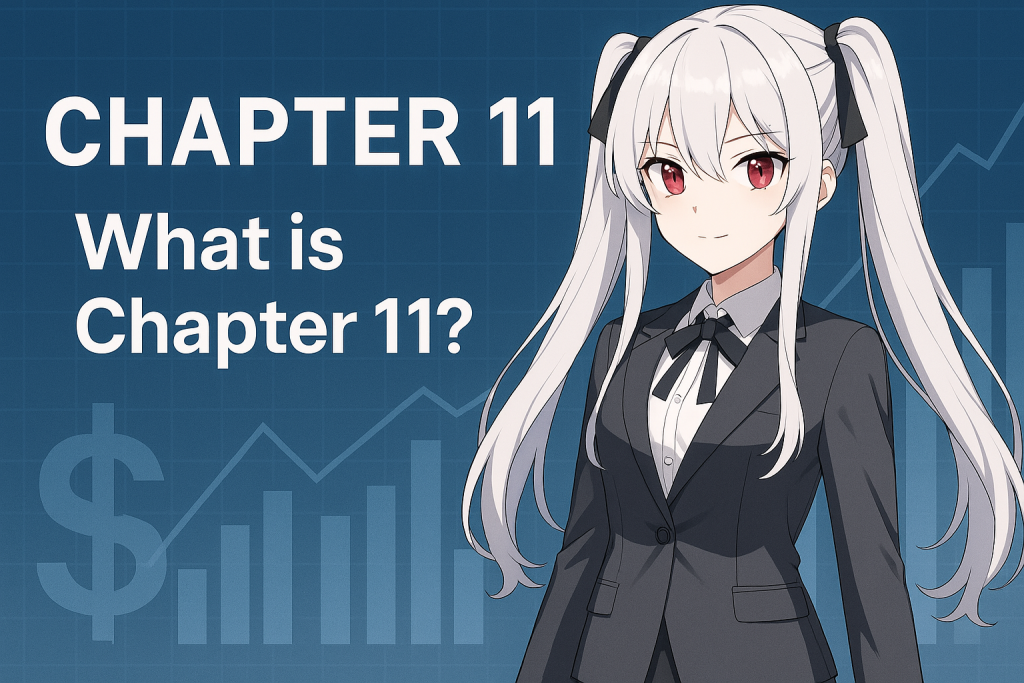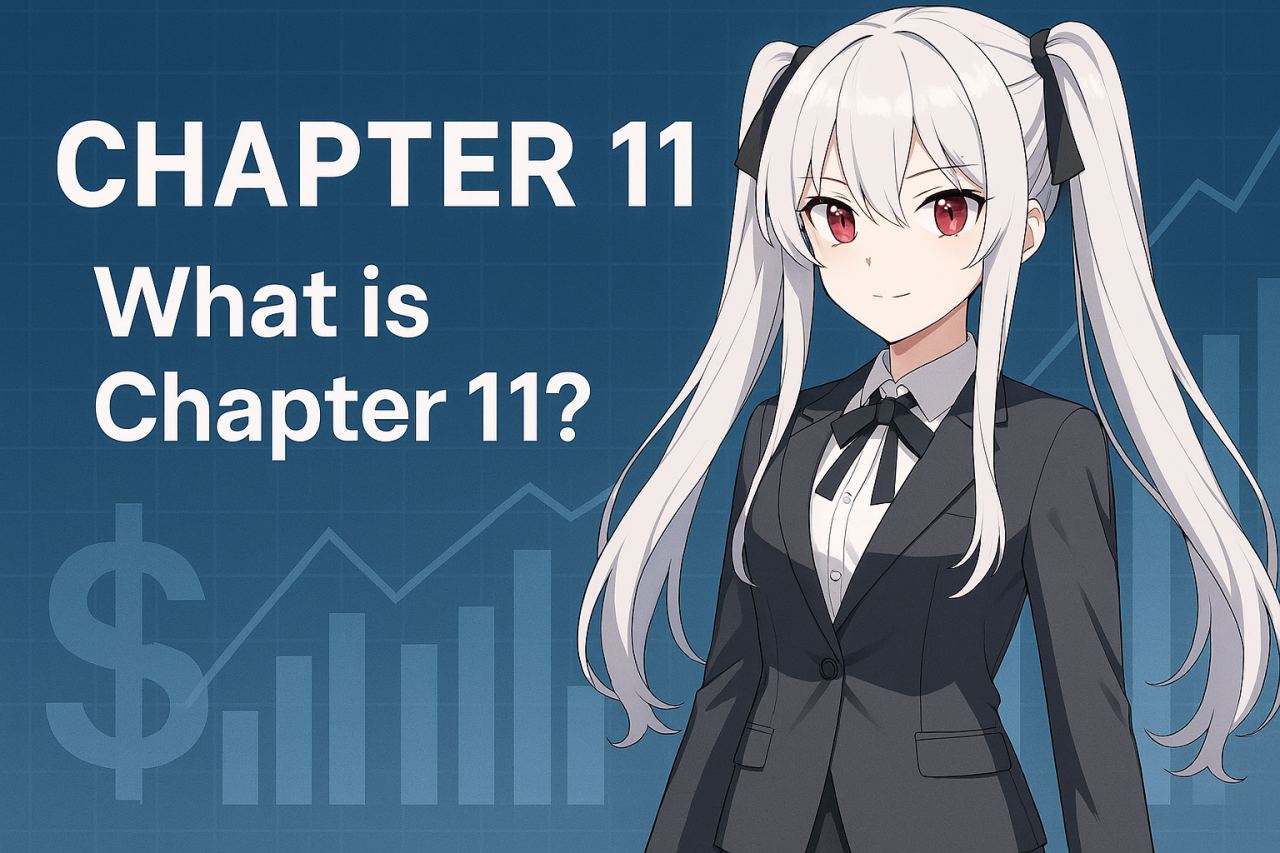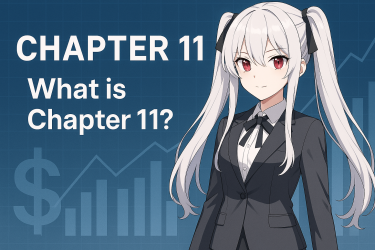- 1 What is Chapter 11?
- 2 Differences from Chapter 7
- 3 Chapter 11 Pros and Cons
- 4 Chapter 11 Procedure Flow
- 5 What is DIP financing?
- 6 Key Points of the Restructuring Plan
- 7 Impact on Japanese Companies
- 8 Roles of Financial Institutions such as Daiwa Securities
- 9 Future Outlook
- 10 Q&A for Understanding Chapter 11
- 11 Summary
- 12 Reference Sites
What is Chapter 11?
Basic Mechanism of Chapter 11
Chapter 11 (Section 11 of the U.S. Bankruptcy Code) refers to a legal process for corporate reorganization under U.S. bankruptcy law. Companies facing a management crisis proceed under court supervision to continue operations while aiming for restructuring.
Companies temporarily halt creditor collection, secure necessary funds to continue operations, and develop a restructuring plan. The plan may include debt relief, changes to payment terms, downsizing of operations, and asset sales.
The purpose of Chapter 11 is to preserve a company’s business value and achieve fair repayment to creditors. Companies reorganize operations and settle debts based on a court-approved restructuring plan.
While this process is challenging for companies, it provides an opportunity for business revival, protects jobs, and contributes to overall economic stability. Management must obtain understanding and cooperation for restructuring through transparent information disclosure and sincere negotiations with creditors.
Differences from Chapter 7
Chapter 7 is a liquidation bankruptcy proceeding under the federal bankruptcy law. Unlike Chapter 11, business continuity is not assumed. The company sells its assets and distributes the proceeds to creditors.
Chapter 7 is often chosen when business reconstruction is difficult, ultimately resulting in the company’s dissolution.
The proceeding is led by a court-appointed trustee, who evaluates, sells assets, and distributes the proceeds to creditors.
The purpose of Chapter 7 is to fairly distribute the company’s assets and protect creditors’ rights.
The choice between Chapter 11 and Chapter 7 is determined by considering the company’s financial condition, future prospects, and creditors’ preferences.
When business revival is possible, Chapter 11 tends to be chosen; when business continuity is difficult, Chapter 7 is preferred.
Regardless of which proceeding is chosen, it is important to seek expert advice and make a careful decision.
Chapter 11 Pros and Cons
Pros
One advantage of Chapter 11 is that it allows a business to continue operating while pursuing restructuring. With creditor collection temporarily halted, you can focus on developing a restructuring plan while improving cash flow.
Additionally, you can use DIP financing (Debtor-in-Possession Financing), a mechanism for raising the funds required for restructuring. Because it is repaid before existing creditors, it enables smoother capital raising.
Moreover, the restructuring plan is highly flexible, enabling you to incorporate debt forgiveness, altered payment terms, and business reorganization tailored to the company’s circumstances.
Cons
On the other hand, a drawback is that the process is complex and costly. Hiring lawyers, accountants, and other experts can lead to substantial expenses.
Also, the freedom of management is limited. Because key decisions require court approval, swift management decisions can become difficult.
Furthermore, if the restructuring plan fails to secure creditor approval, the proceedings may collapse.
Using Chapter 11 requires careful consideration after fully understanding its advantages and disadvantages.
Chapter 11 Procedure Flow
From Filing to Approval of the Reorganization Plan
The filing of Chapter 11 is made by the company’s management. When filing, they submit documents to the court detailing the company’s financial condition and business plan.
Once the filing is accepted, the court sets a creditor reporting period. During this period, creditors must report the amount of their claims.
Afterward, a creditors’ meeting is held, during which management explains the company’s current status and the reorganization plan to the creditors. Creditors can ask questions about the plan and express their opinions.
The reorganization plan is drafted by management and must obtain creditor approval. To secure creditor consent, the plan must be feasible and fair to creditors.
If creditor approval is obtained, the court approves the reorganization plan. Once approved, the company proceeds to rebuild its business according to the plan and reorganize its debts.
Throughout the entire process, transparent information disclosure and sincere dialogue with creditors are essential. Progressing steadily through the procedures with expert advice is the key to successful reorganization.
What is DIP financing?
DIP financing (Debtor-in-Possession Financing) is a form of funding that companies undergoing Chapter 11 proceedings use to continue their operations.
Companies that file for Chapter 11 typically find it difficult to obtain conventional loans. DIP financing is provided to help support a company’s cash flow in such circumstances.
A key feature of DIP financing is that it is repaid with priority over existing creditors. This reduces lenders’ risk and makes it easier for companies to raise funds.
DIP financing is an essential component in realizing a company’s restructuring plan, and its proceeds are used for continuing operations, maintaining employee employment, and repaying creditors.
Typical providers of DIP financing include banks and investment funds. They analyze a company’s business plan and financial condition in detail to determine loan terms.
The interest rate on DIP financing is often set higher than that of conventional loans, but it plays a crucial role in supporting corporate restructuring.
By leveraging DIP financing, companies can effectively utilize their managerial resources and accelerate efforts toward restructuring.
Key Points of the Restructuring Plan
The restructuring plan is a concrete strategy for a company’s recovery and plays a crucial role in shaping its future.
A restructuring plan includes an analysis of the company’s current situation, business strategy, financial plan, and methods for debt restructuring.
To obtain creditor approval, the restructuring plan must be feasible and fair.
To increase feasibility, realistic sales forecasts, cost‑cutting measures, and business reorganization plans must be included.
Additionally, to ensure fairness, creditor rights must be treated equally and undue benefit must be avoided.
When formulating the restructuring plan, it is important to engage in close consultation with not only management but also creditors and experts to build consensus.
A restructuring plan is not finished once drafted; it must be flexibly revised in response to market changes and business conditions.
During implementation, it is important to regularly monitor progress and respond promptly to any issues.
With meticulous planning and execution, a company can successfully restructure and embark on a new path of growth.

Impact on Japanese Companies
Business Expansion within the United States
Japanese companies operating in the United States may be directly or indirectly affected by a business partner’s Chapter 11 filing.
For example, if a partner files for Chapter 11, collecting accounts receivable can become difficult. Additionally, the supply chain may be severed, disrupting product supply.
Furthermore, a downturn in the U.S. economy could lead to reduced sales.
Conversely, if your company is on the brink of insolvency in the U.S., you might consider filing for Chapter 11.
Chapter 11 can be an effective tool for restructuring a business in the United States.
Japanese companies must rigorously manage risk and monitor their operating conditions when expanding in the U.S.
By understanding a partner’s creditworthiness and diversifying the supply chain, risks can be mitigated.
Moreover, if a business crisis occurs, it is crucial to seek expert advice early and consider appropriate responses.
By closely monitoring U.S. market trends and adapting flexibly to changes, sustainable growth can be pursued.
Roles of Financial Institutions such as Daiwa Securities
Financial institutions such as Daiwa Securities provide DIP financing and support the development of restructuring plans for companies undergoing Chapter 11 proceedings.
DIP financing supplies the necessary funds for a company’s continued operations and supports the execution of the restructuring plan.
Financial institutions analyze a company’s business plan and financial condition in detail to determine loan terms.
In addition, when supporting the development of a restructuring plan, they collaborate with the company’s management to create a feasible and fair plan.
Financial institutions also assist in negotiations with creditors and engage in activities to secure agreement on the restructuring plan.
Financial institutions play a crucial role in Chapter 11 proceedings, providing expertise and experience to guide companies toward successful restructuring.
Recently, emphasis has been placed on formulating sustainable restructuring plans that consider environmental, social, and governance (ESG) factors.
Financial institutions promote restructuring plans that incorporate ESG perspectives to support the long‑term growth of companies.
By supporting corporate restructuring, financial institutions also play an important role in contributing to overall economic stability.
Future Outlook
With fluctuations in the global economy and changes in the environment surrounding businesses, the importance of Chapter 11 is expected to continue to rise.
Accelerating technological innovation, intensifying market competition, and increasing geopolitical risks mean that companies must constantly adapt to change.
Companies that cannot quickly respond to changes in the business environment face a higher risk of managerial crisis.
Chapter 11 serves as an effective means for such companies to rebuild their businesses and gain new growth opportunities.
In the future, more efficient and faster Chapter 11 procedures are expected to be required.
Additionally, developing more flexible restructuring plans tailored to a company’s size and industry will become important.
It is crucial for companies to rigorously manage risk and monitor their business conditions to avoid crises and pursue sustainable growth.
Detecting a managerial crisis early and considering appropriate responses with expert advice can determine a company’s future.
In a rapidly changing era, Chapter 11 will further emphasize its role as one of the key options for companies to survive.
Q&A for Understanding Chapter 11
Frequently Asked Questions
We have compiled frequently asked questions and answers about Chapter 11.
We hope this helps deepen your understanding of Chapter 11 through these questions and answers.
Chapter 11 is a complex legal proceeding, and many situations require specialized knowledge.
If you have any questions or concerns, please consult professionals such as attorneys or accountants.
Experts will provide optimal advice tailored to your company’s situation.
Chapter 11 affects not only companies but also many stakeholders such as creditors and employees.
All stakeholders deepening their understanding of Chapter 11 and cooperating is key to successful restructuring.
Companies should prioritize transparent information disclosure and close communication with stakeholders to build trust.
Chapter 11 is an important opportunity for companies to aim for restructuring and should be the first step toward building a better future for all stakeholders.
Q: What happens to stock prices when a company files for Chapter 11?
A: Generally, filing for Chapter 11 negatively impacts stock prices.
This is because investors are concerned that the company’s management situation is deteriorating and future uncertainty is increasing.
It is not uncommon for stock prices to drop sharply after a Chapter 11 filing.
However, if the restructuring plan succeeds, stock prices may recover.
If the restructuring plan gains creditor approval and court authorization, the company can rebuild its business and aim for new growth.
In such cases, investor confidence can be restored, leading to a rise in stock prices.
However, it may take time for stock prices to recover.
Additionally, if the restructuring plan fails, stock prices could fall further.
Stock prices after a Chapter 11 filing fluctuate based on various factors such as the success of the restructuring plan and market trends.
Investors must carefully analyze company information and consider risks before making investment decisions.
Q: What happens to shares held in a NISA account if the company files for Chapter 11?
A: Even if a company files for Chapter 11, the NISA tax‑exempt limit remains in place for shares held in a NISA account.
This is because the NISA tax‑exempt limit applies to capital gains and dividends from stocks, and does not affect the value of the stocks themselves.
However, the value of the shares could decline significantly.
Since stock prices are likely to fall after a Chapter 11 filing, the value of shares held in a NISA account may also decline.
In the worst case, the value of the shares could approach zero.
If a company files for Chapter 11, investors holding shares in a NISA account must carefully consider their next steps.
It is important to decide whether to continue holding or sell the shares, taking expert advice to make the best decision.
If you continue holding the shares, you need to closely monitor the progress of the company’s restructuring plan.
If you sell the shares, you should carefully consider the timing to minimize losses.
Even if a company files for Chapter 11, it is important to persevere and seek the best course of action for shares held in a NISA account.
Summary
Chapter 11 is a critical legal process for companies seeking to restructure.
This process gives companies the opportunity to continue operations while reorganizing debt and formulating a restructuring plan.
However, Chapter 11 is a complex and costly procedure, and success requires leadership from management, cooperation with creditors, and expert advice.
Companies must rigorously manage risk and monitor their operating conditions to avoid crises and pursue sustainable growth.
Responding swiftly to market changes, embracing change without fear, and exploring new business models are key to unlocking a company’s future.
Chapter 11 provides an opportunity for companies to overcome difficulties and start anew, contributing to the revitalization of the overall economy.
Companies must recognize their social responsibilities and actively work toward creating a sustainable society.
High transparency in information disclosure, fair transactions, and consideration for environmental protection—all fulfill corporate social responsibility, building long-term trust and enhancing company value.
By never fearing change, continuously challenging themselves, and contributing to society, companies can achieve sustainable growth.
Reference Sites
米国上場企業の破産:チャプターイレブンとセブンの違いと株式処理について解説のページです。「株」や投資信託を始めたい初心者…












